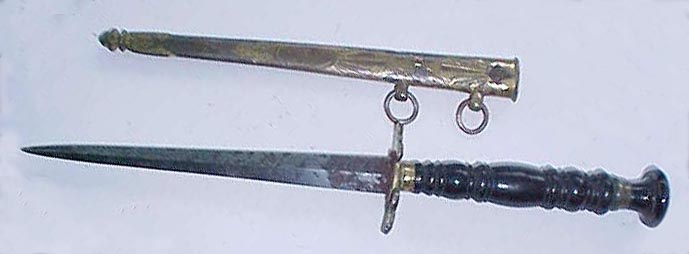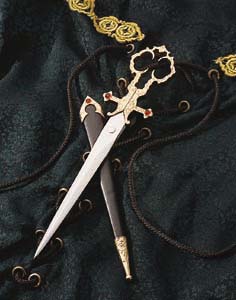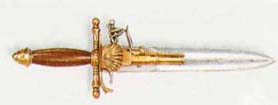Caribbean Tales - Personal Weapons - Daggers/Knives

Daggers
A dagger is anyone of many kinds of fighting knifes (dirks, main
gauche, stiletto,poignard, etc). Daggers were designed to be thrusted at an
opponent. They were not very effective when it came to slashing, although
typically both sides of the blade have an edge. Unlike the Gully, daggers
have hilts or cross bars which prevent the hand from slipping forward on to
the blade and helps to protect the hand in the event of another blade sliding
down the dagger's blade. Daggers were an instrumental part of fencing in that
they were used to parry an attack and keep one's opponent off guard. Many
daggers were specially designed to break an opponents blade. These were called
parrying daggers or blade breakers.
The dagger was not, as often shown in movies, simply a poor back-up in case
one's sword was dropped or broken. It was an integral part of fencing. In
many cases, the sword was used to make an opening or to push an opponent off
balance, then with the opponent exposed, the dagger would be thrusted for
the kill. This is why the sword was often parried or blocked with the dagger,
thus keeping the more deadly cutlass ready for a counter blow. Rarely would
two men lock blades together with their faces inches apart as depicted in
the movies. If one were to get that close, a dagger would most certainly have
come into play.
 A
rapier with matching parrying dagger.
A
rapier with matching parrying dagger.
Note how the hilt forms two almost enclosed circles. The enclosures are designed
to allow an opponents sword to slide down the dagger's blade and be caught
within the circles. If such an event occurs, it makes it possible for the
dagger's owner to snap or at least capture the opponent's sword blade with
a turn of the wrist. Such enclosures are known simply enough as "Blade
Breakers"

A Poinard (Also:Poignard and sometimes Ponyard in Middle English).
The poinard is a stabbing knife often worn by the upper class or noblemen.
Note its similarity to a parrying dagger. The main difference is the poinard
wasn't necessaily designed to be used when fencing.

Naval Dirk
Naval Dirk were often given to midshipman or junior officers. Originally
they were functional fighting daggers but today they tend to be more ceremonial.
This particular dirk is of Irish origin and has a Masonic crest on the scabbard,
and was most likely a gift to junior naval officer. Today, dirks are still
often presented to junior officers and their basic design has changed little
in the last 500 years.
 |
Bodice Dagger Many daggers were designed for concealment, such was the bodice dagger. This item would normally be worn in the cleavage of a woman, running down the front of her corset. In the event that she would find herself in peril she could easily pull the dagger out and surprise her attacker. This particular example also doubles as a pair of scissors! |

DaggerPistol
Another oddity from the 16th-17th Century, is the Dagger Pistol. The idea
was to still have a suitable weapon for close-quarter fighting after you pulled
the trigger and missed. A better idea is pistol and a dagger, or better yet
a pistol and a cutlass.
Dirks
![]()
A Dirk was a particular type of dagger or small knife. In Treasure Island
it is a dirk, like this one from the Eighteenth century, that is thrown at
Jim Hawkins. It is possible that such a dirk was carried by Naval men as well
as pirates, but, still, to a seaman a dagger was a dagger. The style of the
small cutlery was a matter of taste and personal comfort.
Knives
Gully Knife

A gully is simply a big knife. It was not usually a fighting knife but could
be used as such in a pinch. Some gully's were folding knifes but for the most
part they were similar to the knife you would find in your kitchen. (The folding
knifes were smaller.) In any case, the gully was another tool that was commonplace
among sailors and were quite often used in mutinies simply because nothing
else could be had. Today, the Gully would be replaced by such kives as a Buck
Knife or Swiss Army pocket knife.
The gully was better suited for hacking than stabbing and typically only one
side of the blade contained an edge. (In some instances part of the top side
of the blade is also has an edge) It had numerous legitimate uses on board
a ship, being everything from the sailors eating utensil to his main tool
for cutting fouled rigging and such.

Folding Gully
Typical folding knife used throughout the 17th Century and into the 19th Century.
Folding knives had the advantage of taking up less space and could be carried
in a pocket without a sheath.
Pocket Knives
Pocket knives proved popular among sailors and eventually evolved into more
elaborate pocket knives containing othe rutensils, typically a scaling blade,
and marlinespike, and still later such items as cork-screws and even tooth
picks and screw drivers.

English Sailor's Pocket Knife
Typical of the pocket knives issued to sailors throughout the world, this
English pocket knife is from around the end of the nineteenth century. It
is shown here in contrast to the pocket knives used by sailors during the
Golden Age of Sail/Piracy. Even in earlier times, some pocket knives had multiple
blades but such knives would have been a rare treat for the common sailor.
The pointy thing at the top is a marlinespike, a common feature on most multiblade
knives these days, although usually smaller.
Boucan Knife

Modeled after and/or made from broken cutlasses, the boucan knives were originally long bladed knives used when hunting wild pig and oxen on the Islands around Santa Domingo and Jamaica. The knives would be used in cutting the animal apart and preparing the meat for smoking or barbecueing (what the native islanders called "boucan"). A cutlass proves unwieldy when cutting apart animals and smaller knives would not have a strong enough blade to hack through bone and sinew. They came in all sizes and shapes and appear to be nothing more than a cut down cutlass. These knives were still primarily a utility knife but could be used effectively in combat. The were primarily designed to hack or slash an opponent as opposed to stabbing.